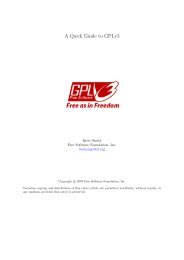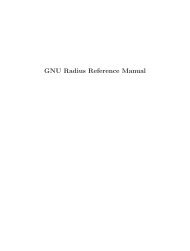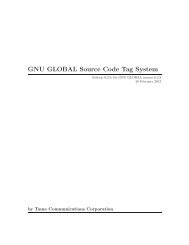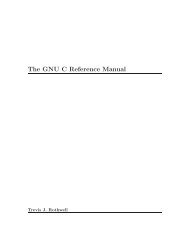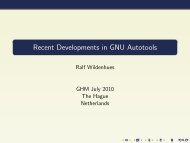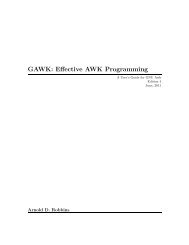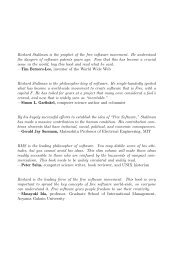by Trent A. Fisher and Werner Lemberg - The GNU Operating System
by Trent A. Fisher and Werner Lemberg - The GNU Operating System
by Trent A. Fisher and Werner Lemberg - The GNU Operating System
You also want an ePaper? Increase the reach of your titles
YUMPU automatically turns print PDFs into web optimized ePapers that Google loves.
18 <strong>The</strong> <strong>GNU</strong> Troff Manual<br />
cause a break automatically, as normally do blank input lines <strong>and</strong> input lines<br />
beginning with a space.<br />
Not all input lines are text to be formatted. Some input lines are requests<br />
which describe how to format the text. Requests always have a period (‘.’)<br />
or an apostrophe (‘’’) as the first character of the input line.<br />
<strong>The</strong> text formatter also does more complex things, such as automatically<br />
numbering pages, skipping over page boundaries, putting footnotes in the<br />
correct place, <strong>and</strong> so forth.<br />
Here are a few hints for preparing text for input to gtroff.<br />
• First, keep the input lines short. Short input lines are easier to edit,<br />
<strong>and</strong> gtroff packs words onto longer lines anyhow.<br />
• In keeping with this, it is helpful to begin a new line after every comma<br />
or phrase, since common corrections are to add or delete sentences or<br />
phrases.<br />
• End each sentence with two spaces – or better, start each sentence on<br />
a new line. gtroff recognizes characters that usually end a sentence,<br />
<strong>and</strong> inserts sentence space accordingly.<br />
• Do not hyphenate words at the end of lines – gtroff is smart enough<br />
to hyphenate words as needed, but is not smart enough to take hyphens<br />
out <strong>and</strong> join a word back together. Also, words such as “mother-in-law”<br />
should not be broken over a line, since then a space can occur where<br />
not wanted, such as “mother- in-law”.<br />
gtroff double-spaces output text automatically if you use the request<br />
‘.ls 2’. Reactivate single-spaced mode <strong>by</strong> typing ‘.ls 1’. 2<br />
A number of requests allow to change the way the output looks, sometimes<br />
called the layout of the output page. Most of these requests adjust<br />
the placing of whitespace (blank lines or spaces).<br />
<strong>The</strong> bp request starts a new page, causing a line break.<br />
<strong>The</strong> request ‘.sp N’ leaves N lines of blank space. N can be omitted<br />
(meaning skip a single line) or can be of the form Ni (for N inches) or Nc<br />
(for N centimeters). For example, the input:<br />
.sp 1.5i<br />
My thoughts on the subject<br />
.sp<br />
leaves one <strong>and</strong> a half inches of space, followed <strong>by</strong> the line “My thoughts on<br />
the subject”, followed <strong>by</strong> a single blank line (more measurement units are<br />
available, see Section 5.2 [Measurements], page 62).<br />
Text lines can be centered <strong>by</strong> using the ce request. <strong>The</strong> line after ce<br />
is centered (horizontally) on the page. To center more than one line, use<br />
‘.ce N’ (where N is the number of lines to center), followed <strong>by</strong> the N lines.<br />
To center many lines without counting them, type:<br />
2 If you need finer granularity of the vertical space, use the pvs request (see Section 5.18.1<br />
[Changing Type Sizes], page 126).





